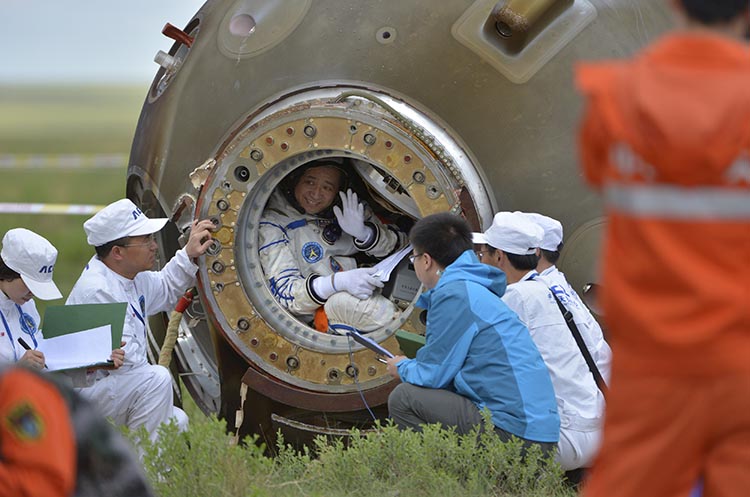The Beidou navigation system – developed with EU help – is a striking example of Beijing’s global dragnet for military know-how.

HONG KONG – Chinese leader Xi Jinping has exhorted the People’s Liberation Army “to get ready to fight and win wars” and “to win regional warfare under information technology-oriented conditions.”
For now, China’s sprawling defense industries and research laboratories are relying on a high-tech short cut. In a vast and carefully coordinated effort, China is scouring the globe for know-how that can be coupled with domestic innovation to produce strategic weapons and equipment.
A year ago this month, technicians at a maker of satellite navigation gear in the Belgian town of Leuven worked over the year-end holidays to test one such breakthrough. The Belgians loaded their receivers with a technical code for a new satellite-navigation system called Beidou, or Big Dipper.
The signal from the new Chinese system provided a surprisingly accurate position fix. “It was certainly better than you would expect from somebody doing this for the first time,” says Jan Van Hees, sales manager for privately owned Septentrio, which plans to sell civilian equipment that can use Beidou’s signal.
It wasn’t beginner’s luck, though. China had help – and it came from European Union headquarters in Brussels, just down the road from Leuven.
Know-how for the Beidou Navigation System, according to interviews with European researchers, a review of diplomatic cables and articles from military and technical journals, came from a technology partnership between Beijing and the European Union. The Chinese essentially piggybacked on a European satellite-navigation initiative, called Galileo, that was meant to rival two existing networks: the dominant Global Positioning System of the United States, or GPS, and Russia’s GLONASS.
Sixteen Beidou satellites are now in orbit, with the network scheduled to expand to 30 when fully deployed by 2020. Europe’s Galileo is expected to become operational next year with 18 satellites. When fully deployed by 2020, the EU constellation will also have 30 satellites.

Senior Chinese military officers have said Beidou is more important to China than manned space flight or the Chinese lunar probes now under way, according to reports in the state-run media. The successful deployment of Beidou means the increasingly potent Chinese armed forces will have an accurate, independent navigation system – vital technology for guiding the missiles, warships and attack aircraft that allow Beijing to claim great power status.
Beidou is one of the most striking examples of China’s global quest to buy, copy or steal the technology it needs to close the gap with the United States and other leading military powers. Highly accurate satellite navigation is fundamental to modern warfare. Aerospace experts say European and U.S. know-how and equipment have been indispensable for China to design, build, launch, position, test and operate its navigation network and other satellites.
The Chinese know exactly what they want and very often know exactly where to find it,” says Oliver Brauner, a researcher on China’s arms trade at the Stockholm International Peace Research Institute’s China and Global Security Project.
Beidou isn’t only about national defense. Beijing sees it as a commercial coup for China’s fast growing market satellite navigation services for cars, mobile phones and other applications. Belgium’s Septentrio and other Western and Chinese companies hope to capitalize by making compatible gear for sale in China and abroad.
The Chinese cabinet on Thursday approved a blueprint that envisioned Beidou capturing 60 percent of a projected 400 billion yuan ($65 billion) market for satellite navigation services in China, according to the English language China Daily. But the report also said that 40 percent of Beidou’s satellite applications would be for military use.
The system is a triumph for the Chinese military-industrial complex. Despite an arms embargo that’s been in place since the bloody 1989 Tiananmen crackdown, the People’s Liberation Army continues to secure much of the military or dual-use technology it needs from the U.S. and the European Union.
THE 863 PLAN
Some Chinese researchers play down the role of European technology in the Chinese network. The EU-Chinese satellite collaboration broke down before the partnership ran its course, they note, and they say one of the reasons was that Europe was withholding key technologies.
China was regarded as a funds provider rather than an equal collaborator” in the project, says Zhang Kefei, a professor and satellite navigation researcher at the Royal Melbourne Institute of Technology and a former president of the International Association of Chinese Professionals in Global Positioning Systems. “They could not get any real benefit from the technology transfer.”
The Chinese Ministry of Defense said in a statement that China mainly relied on homegrown research, development and manufacturing for its military technology. “The Chinese people have the talent and capability to develop and make weapons needed for state security,” the ministry said. “History has proved that, and it remains the same now and will remain the same in the future.”
Beidou fills an important hole for the People’s Liberation Army. China has invested heavily on a massive and expanding arsenal of missiles able to strike targets throughout East Asia, including U.S. bases in Japan and South Korea. Regular reports in China’s military journals and popular military press show Beidou receivers are now in use with infantry squads, amphibious landing vehicles, tanks and artillery, as the technology is adopted throughout the PLA.
Before Beidou, however, the Chinese military had to guide its hardware using civilian signals provided free by the foreign-run GPS or GLONASS. These services aren’t as accurate as specialized military signals – and can be selectively switched off. The United States openly warns it will jam the GPS signal to prevent “hostile use.” With Beidou, China can go it alone.
A generation ago, the opening salvos of the first Gulf War demonstrated to a stunned Chinese military hierarchy how satellites gave the United States and its allies unchallenged knowledge and control of the battlefield. Armed with GPS navigation and data from surveillance and communications satellites, the U.S. coalition pulverized Iraq with smart and conventional weapons. The People’s Liberation Army was rapidly modernizing at the time, but it still had no capacity to match this overwhelming advantage.
China’s military research and development complex accelerated efforts to build a rival navigation network. Space technology was already a key element of Beijing’s “863 Plan.” The 863 directive – named after its March ’86 launch date – came fromDeng Xiaoping, architect of China’s modernization drive. Deng ordained the 863 campaign as one of China’s premier national R&D programs, with the goal of unifying military and civilian efforts to master strategic technologies.
In all of these measures to rebuild China through modern science and technology, the PLA has been a dominant player. Military thinking, goals and organization underpin the management of China’s sprawling network of research and development labs, according to experts on China’s space program. From the start, incorporating foreign technology has been a top priority for domestic satellite makers.
After a series of expensive satellite launch failures in the 1980s and 1990s, China turned to some of America’s leading aerospace companies for technical help. This paid almost immediate dividends for China’s space and missile industry – but led to a backlash in Washington.
A Congressional committee chaired by Californian Republican Chris Cox probed the transfers of sensitive U.S. technology to China. In 1999, the Cox Report found that the United States, Germany and France had provided significant support to China’s satellite programs.
In the aftermath of the report, U.S. aerospace companies Loral Space and Communications Ltd, Hughes Electronics Corp, and Lockheed Martin Corp were fined for providing technical aid to the Chinese satellite program. Lockheed Martin said that U.S. government licenses specifically allowed the transaction with the Chinese entities involved. Loral and Hughes consistently denied they harmed American security in doing business in China.
Washington went on to restrict foreign access to satellite technology. From 1999, this effectively banned the export, re-export or transfer of this equipment or know-how to China. The launch of U.S. satellites from Chinese territory was also prohibited.
GALILEO PARTNERSHIP
Blocked in America, China turned to Europe. European space companies had been collaborating with China through the 1990s. But tech transfers increased sharply when China in 2003 pledged to contribute 200 million euros ($228 million at the time) to join the European Union’s Galileo satellite navigation program.
Galileo was running years behind schedule. Brussels enthusiastically embraced China’s involvement. European space contractors saw cooperation as an opportunity to expand access to the Chinese market while U.S. companies were effectively shut out, industry experts said.
From late 2004, the two sides signed 12 contracts, under which China would deliver key technologies for Galileo’s early development, according to EU and Chinese briefing documents and European Space Agency contract announcements.
The National Remote Sensing Centre of China oversaw these projects, which were to account for 33 million euros of China’s promised contribution to Galileo. The contracts also involved substantial European tech transfers, according to European space industry researchers.
The EU saw little risk. China’s space sector was seen as backward. The PLA was not deemed a security threat to Europe. China’s financial and political support to Galileo was also a welcome counter to U.S. opposition to the rival European network.
“That made it easy to develop this kind of partnership with China,” says Nicola Casarini, security analyst at the European Union’s Institute for Security Studies in Paris. “The Europeans were genuine in believing that cooperation with China was mostly civilian.”
Beijing set up a special company, China Galileo Industries, to coordinate the research and development. The shareholders are some of China’s top military aerospace companies. They include the China Aerospace Science and Industry Corporation, a giant space contractor and missile designer and manufacturer, and the China Academy of Space Technology, a satellite and spacecraft maker.
It is unclear exactly how much European know-how was handed over. EU officials have been reluctant to discuss the transfers when questioned by participants at space industry seminars and conferences.
The European companies then involved in Galileo included the pan-European aerospace giant EADS and Thales SA of France, among others.
EADS declined comment on previous co-operation with China and referred questions on the Galileo project to the European Commission. A spokesman for the commission declined to comment, as did China Galileo Industries. Thales didn’t respond to a request for comment.
Materials from a series of China Galileo presentations at industry briefings in Europe and China after the deals were signed show the projects included a wide range of technology: development related to signals interference in the ionosphere; satellite positioning using lasers; measuring and predicting orbital paths; testing ground-based receivers; and search and rescue functions.
THE BREAKUP
Virtually all of the budgeted funds were spent in China, and the Chinese contractors retained ownership of the resulting hardware and intellectual property, European space industry experts say. However, tension mounted between the two sides.
The EU had always known China had plans to build a military navigation network. But it soon grew clear that China intended Beidou to compete with Galileo. The Europeans also came to realize that China was determined to extract as much dual-use technology as possible for its home-grown satellites. Brussels also grew frustrated at China’s plan to use frequencies for Beidou’s military service that could overlap with Galileo’s restricted signal for European government and military use.
Beijing also grew unhappy. Squabbling between the EU’s many member states and companies over the funding and administration of Galileo caused indecision and delays. The EU network was supposed to enter service in 2008; this has now been pushed back to the end of next year at the earliest.
As China’s know-how expanded, U.S. diplomatic cables released by Wikileaks show, American diplomats and officials urged European governments and aerospace companies to withhold sensitive technology from China in the Galileo partnership.
In discussions with U.S. diplomats, senior EU officials explained how the Chinese had exploited their links with the European project, the cables show.
After signing contracts, Chinese officials from the Ministry of Science and Technology would make “shopping” visits to companies or research institutes across Europe using the agreements as authority for technology transfers, a senior EU official was quoted as saying in a 2009 cable from the U.S. embassy in Brussels. That cable also reported a senior EU official saying that “certain European-manufactured components have been transferred to China against the wishes” of the European Commission, the EU’s executive body. The cable did not say what those components were.
A spokeswoman for the EU’s GNSS Agency, which oversees the Galileo project, referred questions about technology transfer to China to the the European Commission, which runs the EU. The European Commission did not respond to requests for comment.
ATOMIC CLOCKS
One of China’s biggest coups was gaining access to atomic clocks, a key technology Beijing needed for accurate satellite navigation, according to aerospace experts and the leaked U.S. diplomatic cables.
China failed in attempts to buy these clocks from the pan-European aerospace contractor EADS, acoording to the leaked diplomatic cables. However, between 2003 and 2007, China bought up to 20 rubidium atomic clocks from the high-precision Swiss instrument maker Temex Time, now known as SpectraTime, according to industry experts and the diplomatic cables. Articles in Chinese technical journals suggest the Swiss clocks have been fitted to Beidou satellites.
SpectraTime, a unit of Orolia Group, declined to answer questions for this article, referring a reporter to Swiss authorities. Orolia “is known to the Swiss export authorities as a manufacturer and exporter of controlled dual-use goods,” said Marie Avet, a spokeswoman for the Swiss Federal Department of Economic Affairs, but she declined to comment on “specific transactions.”
Chinese companies now appear to have mastered the technology to build these clocks or reverse-engineered the Swiss versions. A March article carried by China’s state-owned China News Service reported that a research unit of state-owned China Aerospace Corp, the No. 203 Institute, began research and development on rubidium clocks in 2004. It has since successfully developed and built 10 of these clocks for Beidou satellites, the article said. “The rubidium atomic clock is the heart of a satellite navigation system,” the article said.
By 2010, Galileo had become a 100-percent taxpayer financed project and came under new rules governing security, technology and procurement. And the partnership with China was effectively dissolved. EU officials assured U.S. diplomats that no Chinese “technical staff will be working on the project and no staff of any type will be working in Brussels,” according to a leaked U.S. diplomatic cable.
By then, however, China was well advanced in a hectic launch schedule for its own network. All 16 satellites in the Beidou constellation have been fired into orbit since April 2007.
The Beidou Navigation System is now playing a crucial role in China’s military exercises, including the Mission Action 2013 military exercise that kicked off on Sept. 10, China’s Xinhua news agency reported this month. The system demonstrated a capability of covering PLA units fighting on multiple fronts simultaneously.
“The era of China relying on a foreign satellite navigation system is in the past,” Xinhua said. “The era of China’s Beidou has arrived.”
(Additional reporting by Tim Hepher and Caroline Copley)





